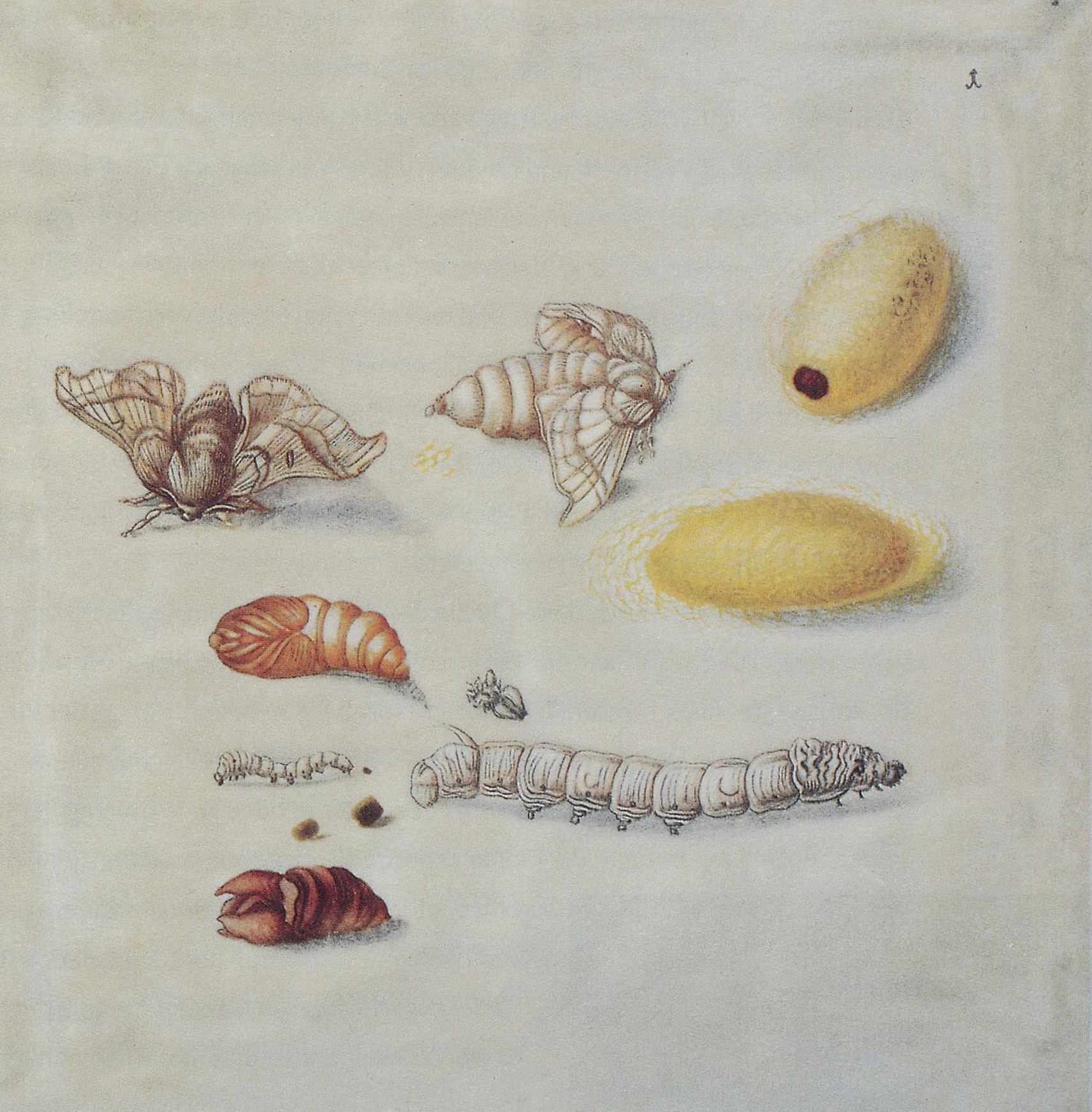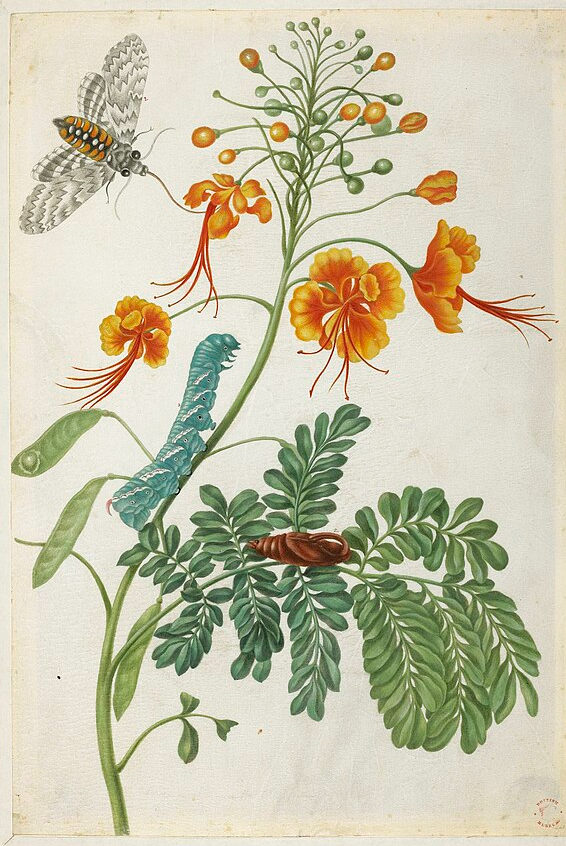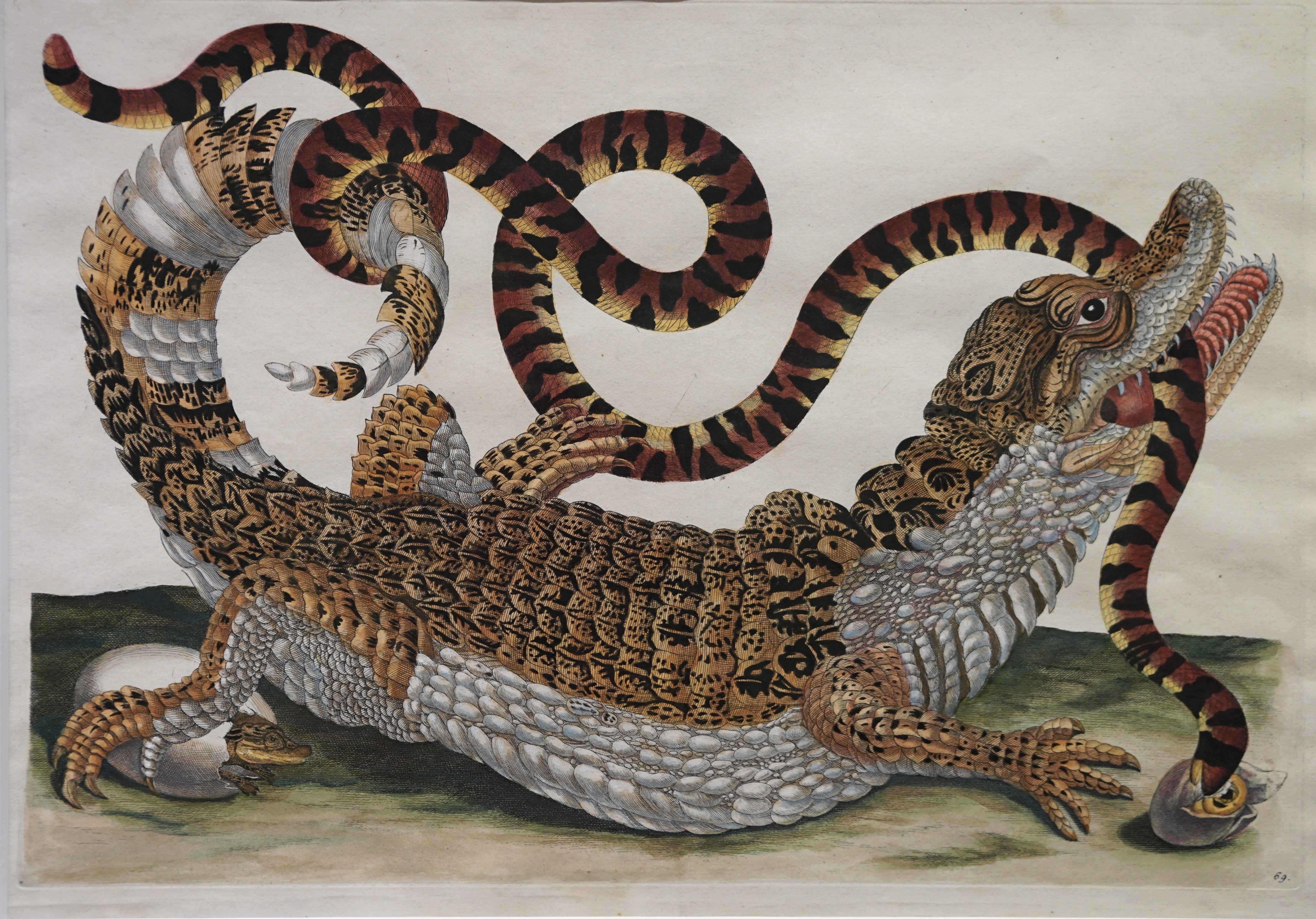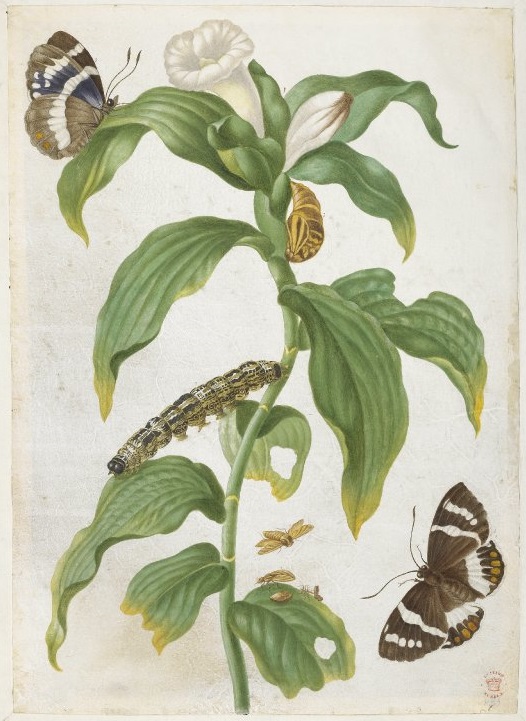This woman is something entirely different from the other artists I’ve already covered in this series. The previous women created Art, with a capital A, and if they had any other motives, it was because bills have to be paid and adulation is nice. Maria created art, but only as a means to an end. Her real interest was bugs. Yep, the creepy crawlies that most of us would rather not think about. That’s what she liked.
She was born in 1647 in the city of Frankfurt. The Germany of her time was neither unified nor healthy. The Thirty Years War had just ended, along with the lives of roughly one-third of its people. The plague had recently claimed a whole lot more people. And yet Frankfurt was hopping. Many major land routes crossed there, and their relative religious freedom brought in a vibrant community of refugees fleeing other less enlightened places.
The Merian family were Calvinists and successful printers. The family motto was Pietas contenta lucrator which I have seen variously translated as “pious diligence wins” (Todd, 26) or the more blunt “industrious piety pays” (Pomeroy, 21). In other words:
Serve God and make a lot of money.
The publishing house specialized in expensive books: ones with lots of pictures and maps. Some of them showed the amazing things pouring into Europe out of the New World. Those would have been unbelievably expensive in past centuries (even if they’d known about the New World), but the Merian press could print 200 pages an hour. And all of those books would have been just lying around the house for a daughter to thumb through.
An Education in Art (and Bugs)
But her father died when she was just three years old. Her brother took over the business, and her mother remarried. She married an artist named Jacob Marrel. Presumably, Maria learned to paint by hanging around in her stepfather’s workshop. He was a specialist in flower paintings, which he often accented with butterflies, caterpillars, and bees. Presumably he needed models for all of the above, and that sounds like a very good task to give to a child underfoot.

She may also have gone to school. The German principalities were some of the first to require elementary education for boys and girls, though reality didn’t always live up to that aspiration. Certainly Maria learned to read and write somewhere.
But neither school nor the art studio was going to teach her what she really wanted to know. She wanted to know where the insects came from and none of the books in her family publishing house could give her an accurate answer to that. Most of the experts were still quoting Aristotle on that and he said that “their production is spontaneous, for some of them spring from the dew which falls on plants… Some originate in rotten mud and dung, and others in the fresh wood of plants or in dry wood” (Aristotle, Book V, chap 17).
Maria either didn’t know her Aristotle or wasn’t satisfied by that spontaneous explanation. At the age of 13, she “set aside her social life”—her words—and began collecting insects (Pomeroy, 15). “This research I started in Frankfurt in 1660,” she later wrote. “Thank God.” she added (Todd, 37).
You can only imagine what her mother thought as her daughter began bringing caterpillars home in boxes and feeding them lettuce.
Marriage and Family
Of course, the expected pattern of her life was that Maria would get married and help her husband with his career and raise children. And love showed up. Or maybe not love necessarily, but a groom anyway. Johann Andreas Graff was a former apprentice of her stepfather. And when they married in 1665, he was 28. Maria was 17. They lived in Frankfurt for three years and had a daughter named Johanna. Then they moved to Johann’s hometown Nuremberg.
Plenty of later generations of parents would worry when their daughters wanted to marry artists, but for Maria it was a good choice. Many guilds wouldn’t allow women to join and therefore they couldn’t sell their work. But wives of guild members could, so that was her entry. And she did paint (mostly flowers) on vellum, silk, and linen and sold her work. Watercolor was considered more appropriate for women than oils, and that is the medium she worked in. She also sold art supplies and took in students. These students were all girls from wealthy families, so this wasn’t the formal apprenticeship that middle class boys got, but it was an education of a sort. They were learning to paint and embroider and to make their homes beautiful, not to make a living (Pomeroy, 27-28).
In 1675, Maria published her first book of flowers. In contrast to her later work, this was not a scientific study. The stated purpose was to serve as a pattern for drawing, painting, or embroidery. You’ve got to take the word book a little loosely because you wouldn’t recognize it as a book. Buyers got twelve loose sheets, each with a blossom or two, and if you wanted it bound you had to take it to a bookbinder yourself. If you were cheap you got the black and white version, printed from lines engraved on a copper plate. You had to pay more for the colored versions which were individually hand painted by Maria (Pomeroy, 29). These were successful enough that Maria published two more sets of twelve in 1677 and 1680.

Even though these books were purely decorative guides, much like the ones you can find in your local craft store today, Maria herself was not really interested in the purely decorative, nor the purely edible for that matter. She was, of course, also a housewife, responsible for the feeding of her family. Here’s a sample of how that part of her life went.
One day she had three birds to cook for dinner. She writes:
Three hours later, as I was about to pluck them, there were seventeen fat maggots on them. . . . The next day they changed into completely brown eggs. On August 26th there came out many pretty green and blue flies. I had great difficulty catching these flies, since they were so fast. I got only five of them. All the others escaped.
quoted in Pomeroy, 26
So not your average housewife. The question is, what did she tell the family when they showed up for dinner? I don’t know.
In 1679, Maria published her first book of caterpillars and this was not decorative. She carefully depicted the entire life cycle, food, habitats, and parasites, all with descriptions and beautifully detailed paintings.

This made her one of the world’s first entomologists and ecologists. She was so early on this that those words didn’t even exist yet (Pomeroy, 34). Even the distinction between artist and scientist was blurry. Her intro has the language of both (Todd, 77).
Meanwhile, Maria gave birth to her second daughter Dorothea in 1678. The two girls were ten years apart and the only children we have record of. Writer Kim Todd wants to make much of this, pointing to marital unhappiness. Given what happened later, that may be true, but Maria’s study book is full of art and science, not personal details like how she felt about her husband. And given the prevalence of miscarriages, stillborns, and infant mortality, there’s really no need to assume anything about relationships.
In 1681, Jacob Marrel died and Maria’s family moved back to Frankfurt to live with her widowed mother. The inheritance was disputed and Maria filed a lawsuit against her stepsister. Maria won.
In 1685, Johann Andreas returned to Nuremberg alone.
Joining the Labadists
Maria, her daughters, and her mother joined a religious group in Holland called the Labadists. The Labadists believed in simplicity: simple food, coarse clothing, no jewelry. Resources were pooled. Here again, I really wish Maria had written more of her personal thoughts. Was she a true believer and Andreas just wasn’t down with all this austerity? Was she fleeing her husband and this was a way to do it? Did Andreas want to come but get refused entry by the authorities? Or did he want to come and she personally refused him? Those last two theories get mentioned occasionally, but as far as I can tell the sources on that are sketchy. We just don’t know the motivations, but I can only imagine that it involved pain, one way or another.
A few years later, Johann Andreas Graff filed for divorce and got it. They probably never saw each other again.
Throughout Maria’s time in the colony, she saw evidence of the New World. The Labadists sent colonists to Maryland and Surinam. They were considering an overseas colony. Their scouts sent back artifacts and specimens of what they had seen and in many cases, had died for.
And on to Amsterdam
In 1691, it was time for another radical life change. Maria packed up her two daughters and moved to Amsterdam. Again, it’s hard to know exactly why. Living with the Labadists was a retreat from the sins and pleasures of a fallen world. Amsterdam was the very heart and soul of that fallen world. The Dutch Golden Age had been in full swing for over a century. Amsterdam was the center of trade, art, culture, everything. It was four times the size of Nuremberg and five hundred times the size of the Labadist colony. Perhaps that was thrilling. Or maybe it was terrifying. Most likely some of both.
Maria arrived as a single woman with skills but not a lot of capital. She had a daughter on the cusp of womanhood and another who was still a child. It is honestly a miracle how well this worked. Maria called herself Madame Merian which was sort of misleading. Merian was her maiden name. She had dropped the Graff. Calling herself Madame gave her the clout of having been married. At least some of the time she portrayed herself as a widow, which was respectable (and untrue), rather than as a divorced woman which was much less respectable (and true).
Johanna, the oldest daughter, quickly married a local businessman, who had previously been a Labadist, and that undoubtedly helped. But Maria was independent, selling her art and also seeds, plants, and animals. All over Europe collectors and budding scientists were selling, buying, and swapping specimens. Maria entered this world. She was soon good friends with the main man in Amsterdam: Frederik Ruysch who had an enormous collection. She undoubtedly also met his daughter Rachel, who was a highly successful flower painter in her own right.
Maria’s art was admired for its accuracy (not necessarily a goal for most of our previous artists) and in Amsterdam she had access to strong magnifying glasses to see all the details on her beloved caterpillars. Johanna and Dorothea both helped in the studio, but the paintings were always signed Maria Sibylla Merian. She, after all, had the famous Merian name, known to many of these same collectors for her father’s publishing house.
So there she is: successful and independent, and it still isn’t enough. She doesn’t know enough, hasn’t done enough, and here’s where the story gets crazy.
Once upon a time, back in grad school days, my husband and I would think about how we really didn’t want to get up and do the daily grind, and we’d ask ourselves well, what would happen if we liquidated our meager assets and bought tickets to Europe for today? And we’d go online and see how much it costs to do that today, and then we’d quietly go back to the daily grind.
Well, Maria Sibylla Merian was more adventurous than me and she really did it. In reverse, of course, since she was already in Europe. In 1699 at the age of 52, she sold her entire collection of 255 paintings, plus all her specimens, most of her household goods, everything except the supplies she needed to move to Suriname. Suriname (in case it’s been a while since your last geography lesson) is a teeny tiny little country on the north coast of South America.
Adventures in Surinam
Despite its size and relativeness newness to the Eurocentric worldview, Maria was not the first European woman to go. She’s not even the first European woman on this podcast to go. Aphra Behn (episode 8.2) had already been and gone. The difference was that Surinam was now a Dutch colony, not an English one because the English had traded it for an insignificant speck of land called Manhattan.
Otherwise it was much the same: still hot, humid, buggy, and filled with the agony of suffering natives and African slaves. The very small European population collected the profits on their labor. That was the purpose of the colony.

Getting there was triky enough, since it involved a serious risk of shipwreck, starvation, seasickness, disease, and pirates. But at least Maria was not alone. Dorothea, now 21, came along too. Also live caterpillars. Maria packed those as well (Todd, 146).
They made it. At least Maria and Dorothea did. I’m not sure about the caterpillars.
Paramaribo, the colony’s capital, was a few miles inland from the coast. A few hundred Europeans lived there in wooden houses connected by streets of crushed seashells. Most of the inhabitants were men. There were probably no other European women without a male relative for protection.
All of the men were there as soldiers, or plantation owners, or sailors, or agents of Dutch West India Company. None of them were there to paint. The only local life form they cared about was sugarcane. Certainly none of them cared about caterpillars. Maria wrote that “the people there have no desire to investigate such things; indeed they mocked me for seeking something other than sugar in that country” (quoted in Pomeroy, 54).
Undaunted, Maria set to work. It wasn’t hard to find the creepy crawlies. They invaded her house. Also, it was a shock to find that they were not so defenseless as the ones at home. Some of them made her hands swell up when she touched them (Pomeroy, 55).
Together mother and daughter ventured into the rain forest (despite their utterly unsuitable clothing) and questioned the Indians on what they found. They also ventured onto the plantations. Like pretty much everyone else of the period, it never occurred to Maria to call for abolition, but that does not mean she approved of what she saw. In her descriptions of the peacock flower, she added this comment.
The seeds of this plant … are used by women who have labor pains in order to hasten the birth. The Indians (who are not well-treated by the Dutch), use the seeds so they will not produce children, so that their children will not become slaves like they are. The black slaves from Guinea and Angola have demanded to be treated well. Otherwise they refuse to have children. In fact, they commit suicide because they are treated so badly. They believe that they will be born again, free and living on their own land. They told me this themselves.
quoted in Pomeroy, 57

Maria employed men and women of both races during her time in Surinam. The Africans she referred to as slaves, but whether she bought them outright or hired their services from their owners, I do not know. She could not have learned as much as she did without help from both Africans and Indians, but I do not have names or details about any of these people. She wrote that slaves should be treated kindly. We can only hope she followed her own advice.
With their help she grew, raised, and documented an incredible array of wildlife and yet it was hardly a dent in what she wanted. The jungle was dense and vast and she often could not keep her specimens alive long enough to see the full life cycle. The plan was to stay for five years. But the weather and the mosquitos took their toll. It’s unclear what sickness overtook her, but malaria is a good guess. Maybe yellow fever.
She lived, but barely.
After a mere two years, she called it quits. It was not as much as she had hoped, but she had sketches and notes and crates upon crates of preserved specimens and it was time for another terrifying sea voyage. She lived through that too.
Publishing and Aging
Back in Amsterdam, it was still a great deal of work to put together her book. With her notes and specimens before her she drew and painted everything the way she wanted it: not decoratively, but scientifically, showing life stages, food supplies, and surrounding habitat. Johanna and Dorothea helped. Though beauty was not the point, they are exquisitely beautiful. Engravers were hired.
To pay for the engraving and printing, Maria used a common method at the time. She convinced subscribers to pay up front. The book would be delivered later. In 1705 it was done: Insects of Surinam in Dutch or Latin with 60 illustrations, most of them life-size because the pages were 14 inches wide and 21 inches tall. There is no earlier book to compare with this one. It was something new.

Maria was already somewhat famous and now she was more so. Scholars across Europe knew of and praised her work. One of them asked her to illustrate his book of curiosities, which she did. Hordes of people trooped through her home to see her and her collection. She still found time to revise two volumes of her caterpillar book and to plan still more volumes.
But age (and possibly malaria) was catching up to her. On May 28, 1711, Maria drew the last entry in her study book. She lived for six more years, but she was increasingly ill and frail and unable to paint. Dorothea finished the caterpillar volume and published it, but not before her mother died at age 69. During her life Maria Sibylla Merian achieved fame, and if not fortune exactly, then at least a living, which was no mean feat for a woman working in art and science.
The Post-Mortem
The story of her work after her death has almost as many unexpected twists as her life. The very month that she died, Peter the Great, Czar of Russia, was in Amsterdam. He hired Georg Gsell to advise him on art purchases and ended up with most of Maria’s work. Gsell just so happened to be married to Dorothea by this point.
Peter the Great was eager to turn a new city he had modestly named St Petersburg into a great center of culture and learning. To that end he was collecting not only art and specimens, but also people. He included Dorothea and her husband. Dorothea was commissioned to design his curiosities exhibits and document them in watercolor. The people who admired these exhibits surely included Peter’s daughter Elizabeth, who later became empress (episode 2.4) and Peter’s granddaughter-in law, Catherine the Great (episode 2.5).

Meanwhile, Maria’s published works were still circulating and enjoying high accolades. In 1735 Carl Linnaeus invented the system of scientific naming that we still use today. You know, the one you learned in biology class with kingdom, phylum, class, order, family, genus, species. Linnaeus didn’t have direct observations of every species to work from, so he relied on the published work of scientists he respected, including Maria’s. He cites her 37 times (Todd, 237).
Unfortunately the very fact that her work was valued led to problems. There were reprints and reprints of reprints. Publishers added their own material or garbled her comments or worked from black and white copies and hired artists to add colors which they chose from their imaginations.
By the 19th century, scientists took themselves very seriously, and artists were something else. Something lesser at that. In 1834, one of them published a scathing critique of Maria Sibylla Merian. Worthless, vile, and befuddled were among the adjectives used (Todd, 243). Examination reveals that the critic was using one of the garbled editions of Maria’s work, so that explains some of it. On some points, science has proved her right, not him. And occasionally he did catch her in a genuine error. It happens to us all. But her reputation was ruined.
One painting was repeatedly pointed out as absurd. It’s her spider page. Among other things it shows a spider eating a hummingbird, which was obviously fanciful, the stuff of nightmares, clearly drawn by a woman, who (as we all know) are given to gullibility and hysterics. One naturalist even attempted to prove it. Tarantulas live in tunnels; hummingbirds do not. So he released a hummingbird into a tarantula tunnel to see if it became a meal. When the traumatized spider fled, it was taken as proof that Maria was an idiot (Todd, 242).

Unfortunately for bird-lovers everywhere, it’s Maria who was right on this. The Goliath Bird-Eating tarantula is one foot wide, lives in northern South Americans eats frogs, rodents, and occasionally birds. It’s true that they don’t often eat birds, but occasionally they do. You’re welcome for the nightmares. (National Geographic, Smithsonian’s National Zoo). But the 19th century didn’t know that and Maria slipped into obscurity.
In 1994, the library of the Academy of Sciences in the Soviet Union published fifty of Maria’s watercolors from collections that had been there since Peter the Great. There were many reprints afterwards, and by looking at her actual work, rather than reprints, Maria’s reputation was revived. In many cases, her depictions are so accurate that modern entomologists can use the Linnaen system to name the exact species she was looking at.
In terms of science, Maria’s greatest contribution was a sense of ecology: the idea that it mattered not just what an animal was now, but also where it came from, where it was going, and what lived around it.
In terms of art, she was finding beauty in places that artists hadn’t looked for it before.
For those of us who are neither scientists nor artists, there is still that indomitable spirit of adventure. I hope you are inspired.
Selected Sources
Aristotle. Aristotle’s History of Animals. In Ten Books. Translated by Richard Creswell. Gutenberg, 1862, http://www.gutenberg.org/ebooks/59058. Accessed 20 Apr. 2023.
National Geographic. “The Biggest Spider on the Planet | Bite, Sting, Kill.” Www.youtube.com, 2018, http://www.youtube.com/watch?v=cBL-5mOGHt8&ab_channel=NatGeoWILD. Accessed 23 Apr. 2023.
Pomeroy, Sarah B, and Jeyaraney Kathirithamby. Maria Sibylla Merian Artist, Scientist, Adventurer. Los Angeles, Calif. The J. Paul Getty Museum, 2018.
Smithsonian’s National Zoo. “Goliath Bird-Eating Tarantula.” Smithsonian’s National Zoo, 5 July 2018, nationalzoo.si.edu/animals/goliath-bird-eating-tarantula.
Todd, Kim. Chrysalis : Maria Sibylla Merian and the Secrets of Metamorphosis. Editora: Orlando, Harcourt, 2007.
Valiant, Sharon. “Maria Sibylla Merian: Recovering an Eighteenth-Century Legend.” Eighteenth-Century Studies 26, no. 3 (1993): 467–79. https://doi.org/10.2307/2739414.

This woman sounds like a kindred spirit for my middle child, Lottie. At nine years old, she wants to be a bug artist. We definitely do not discourage this.
LikeLike
Hooray for Lottie! Draw those bugs!
LikeLike
[…] who painted because it was the family business, women who painted because they needed money, a woman who painted for science, even a woman who painted because ancestral spirits told her to, but Frida is the only one who […]
LikeLike
[…] in episode 10.6, I talked about how Maria Sibylla Merian sold her books with illustrations of the natural world, and they came in two versions: the black […]
LikeLike